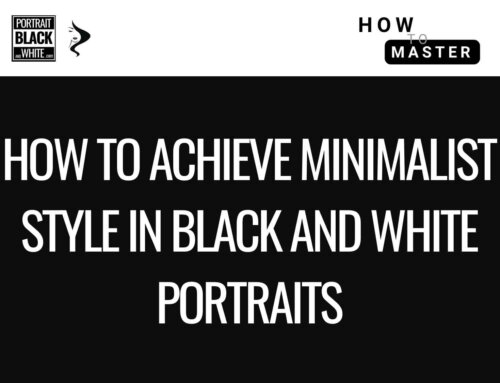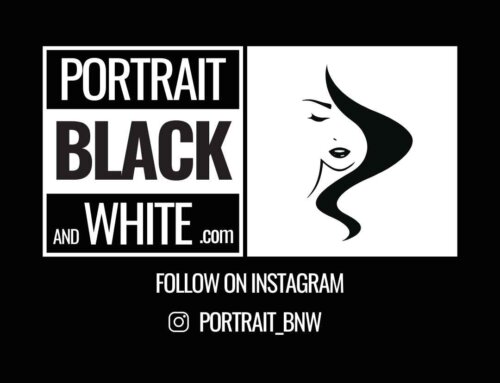Contrast is the backbone of every black-and-white portrait. It shapes the face, suggests mood, guides the eye and, if handled with care, reveals delicate texture instead of crushing it. “More contrast” is not always the answer; better contrast is. The goal is to place tones where they serve the subject—deep enough to feel dimensional, gentle enough to protect skin detail and highlights.
Below is a practical, field-tested approach that balances global contrast (overall punch) with local contrast (micro-separation in features like eyes, lips, hair and fabric). It works whether the light is natural or artificial and whether the workflow is mobile or desktop.
Start at capture: shape contrast before touching sliders
Editing can’t fully recover poor tonal decisions on set. A thoughtful approach during capture gives far more freedom later.
Meter for highlights you want to keep. In monochrome portraits, specular highlights on cheekbones, forehead and nose are where detail is most fragile. Watch the histogram and highlight warnings; if those areas clip, they turn to plastic. Preserve headroom in bright skin while keeping shadows printable—especially in backlit scenes or hard midday light.
Decide the lighting ratio, not just the light source. Two portraits can use the same window and still look completely different depending on fill. A small negative fill (black card or flag on the shadow side) deepens cheek and jaw separation without pushing blacks to zero. Conversely, a subtle white reflector at low power lifts eyebags and preserves micro-texture that would vanish if shadows fall too far.
Control background tone. Backgrounds silently dictate perceived contrast. A mid-gray wall with soft spill yields gentle portraits. A dark, non-reflective backdrop instantly increases subject separation—often more elegantly than cranking global contrast later.
Choose angle over intensity. A slight turn of the face relative to the key light can add sculpting that no slider can replicate. Short lighting (shadowed cheek toward camera) tends to create depth; broad lighting (lit cheek toward camera) flattens. Small angle changes ≫ big exposure changes when the goal is form.
Global vs. local contrast: treat them as separate tools
Think of contrast in two layers:
-
Global contrast sets the overall dynamic range—the “punch” seen from across the room.
-
Local contrast controls fine separation—the pores, lashes, strands of hair, linen texture and lip definition that hold attention up close.
Overusing global contrast to chase drama usually sacrifices local detail. The reverse—overprotecting detail—can lead to flat, lifeless files. Balance the two deliberately.
A reliable editing sequence (app-agnostic)
This sequence avoids fighting your own adjustments and keeps detail intact. Names vary by software, but the concepts map across Lightroom, Capture One, Darktable, Affinity, etc.
1) Neutral black-and-white conversion first
Convert to monochrome early so tonal judgments aren’t skewed by color. Use a channel mix/HSL-based conversion rather than a one-click preset. Small changes in how reds, oranges and yellows map to gray will dramatically affect skin tone separation and blemish visibility.
-
Lightening reds/oranges typically brightens skin.
-
Darkening blues deepens denim, the sky or cool backgrounds, improving subject separation.
-
Slightly darkening greens can push foliage behind the subject so the face pops without extra contrast.
Avoid extreme channel moves that create halos where colors meet (e.g., hair against a blue sky).
2) Set anchors: white and black points with restraint
Establish a true white point in a highlight you want to feel luminous but still textured (upper cheek, forehead rim light, sclera catchlight). Then set black point where the image can afford depth (hair mass, jacket folds, deep background). If either anchor clips heavily, local contrast later will produce mush or halos.
Tip: if the file looks dull after honest anchors, resist the temptation to crank global contrast; hold that urge for the next steps.
3) Shape the midtones with curves, not “Contrast”
Use a custom S-curve instead of the global “Contrast” slider. Place a gentle lift in upper midtones (skin) and a mild pull in lower midtones (shadows around jaw and hairline), leaving extreme highlights/shadows relatively untouched. This yields dimensionality without burning texture.
For subjects with deep skin tones, avoid making the entire face live in the lower quarter of the curve. Lift midtones selectively to keep richness while preserving headroom for catchlights.
4) Add local contrast where the story lives
Now target micro-areas:
-
Eyes and lashes: modest clarity/structure or a fine-radius high-pass to separate lashes from lids. Keep it subtle—oversharpened eyes break realism.
-
Lips and philtrum: a small dodge on the highlight ridge, a micro-burn in the crease. This gives form without lipstick-like artifacts.
-
Cheek and jaw transitions: use negative clarity or a tiny blur on broad skin patches to keep them silky, then re-introduce texture only along edges that define shape. This contrast inversion (soft planes, crisp edges) reads as high quality.
Local tools (brushes, radial masks, luminosity masks) are your allies. They encourage precision and protect texture.
5) Control texture with three separate levers
“Sharpening,” “Clarity/Structure” and “Texture” aren’t interchangeable.
-
Sharpening (small radius) enhances edges; too much creates halos along hairlines and wrinkles.
-
Texture emphasizes fine detail like pores and fabric weave; it’s excellent when kept near the face’s focal plane.
-
Clarity/Structure boosts midtone contrast regionally; it can thicken skin if overdone.
Use smaller values across multiple levers rather than maxing one. The cumulative effect looks cleaner.
6) Dodge & burn to guide, not decorate
Classic dodge and burn remains the most respectful way to control contrast. Think in broad zones first (forehead, cheeks, jaw, neck), then edge accents (brow ridge, nose bridge, lip line). Work at low opacity; several subtle passes build believable depth. Keep burns off pores and fine wrinkles to avoid emphasizing them.
7) Noise reduction last—and only where needed
Luminance noise reduction smooths texture quickly. Apply it selectively to low-detail areas (background, shadow fields) and protect high-frequency zones (eyes, brows, stubble, hair). If the portrait relies on an elegant grain, reduce chroma noise but leave luminance structure intact, then add controlled grain later for cohesion.
Using color filtration in a monochrome world
Physical color filters (in film days) and digital channel weighting (today) do the same job: they relocate tones before contrast is applied.
-
A red/orange bias brightens most skin and can minimize freckles while darkening cool backgrounds. Useful for high-key beauty without destroying cheek texture.
-
A green bias brings out skin texture and can enhance separation in foliage—great outdoors, but use lightly on close-ups.
-
A blue bias darkens lips and veins and can emphasize blemishes; it’s potent for gritty character studies but unforgiving.
Rather than extreme settings, think in small nudges combined with local edits. The aim is to pre-organize tones so later contrast boosts help, not harm.
Lighting choices that protect detail
Two portraits can share identical exposure and still differ in perceived contrast because light quality changed.
-
Large, close sources (big window, softbox near the subject) create soft transitions that accept more global contrast in post without banding or harshness.
-
Hard light (small source far away, midday sun) draws crisp borders and deep cores; it demands careful fill to keep pores and wrinkles from becoming the picture.
-
Feathering the light—aiming the brightest part just off the face—softens specular hits while maintaining direction.
-
Edge light or rim light expands dynamic range and clarifies hair against backgrounds. Keep it a stop or so below the key if the look should remain soft and natural.
Small flags, scrims and reflectors are inexpensive ways to “edit before editing.”
Minimalist high-contrast looks without crushed skin
High-contrast monochrome doesn’t have to mean chalk-and-soot. A clean recipe for modern punch:
-
Protect highlight texture during capture (zebras are your friend).
-
Convert to B&W with a slight warm bias (reds/oranges a touch up) to flatter skin.
-
Set anchors gently; don’t pin whites to 100% unless it’s a specular catchlight.
-
Build a midtone-focused S-curve; leave actual blacks and whites near their natural positions.
-
Add local structure only to eyes, hair edges and clothing seams.
-
Burn the frame edges a whisper to hold attention center-face; keep gradients smooth.
The result reads bold on small screens yet prints with nuance.
Troubleshooting: fix contrast without sacrificing detail
The skin looks plasticky after adding contrast.
The white point is likely too high or clarity was applied globally. Pull back whites, add micro-contrast selectively to hair/eyes, and use negative clarity on broad cheek planes to restore realism.
Shadows look muddy, not rich.
Global blacks may be too low. Raise black point slightly, then burn specific creases (under jaw, hair mass) to reintroduce perceived depth without drowning midtones.
Eyes are sharp but still don’t pop.
Contrast might be uniform across the face. Add a soft dodge to iris highlights and a subtle burn to the upper lid crease; reduce texture on the lower eyelid skin so the crisp iris stands out.
Fine lines and pores are overemphasized.
Local clarity likely hit the wrong areas. Mask it out of under-eye regions and nasolabial folds; keep micro-contrast to brows, lashes and hair.
Prints look dull compared to the screen.
Screens backlight; paper reflects. Add a gentle print-intent curve (tiny midtone lift and a hair more black density) and soft proof for the chosen paper profile when available.
A simple, repeatable mental model
-
Preserve: highlights with information are sacred.
-
Place: choose where midtones live—this decides mood.
-
Partition: separate subject from background with tone, not just sharpness.
-
Polish: add micro-contrast only where viewers must look.
-
Proof: view at print size and on a phone; both should hold detail gracefully.
Final thought
Great monochrome contrast is less about aggression and more about restraint. Deep blacks and bright whites feel powerful only when everything in between has room to breathe. By shaping light at capture, mapping color wisely in conversion, and building contrast locally rather than globally, black-and-white portraits gain that rare mix of punch and tenderness—the kind of look that holds attention without shouting.




Scrivi un commento